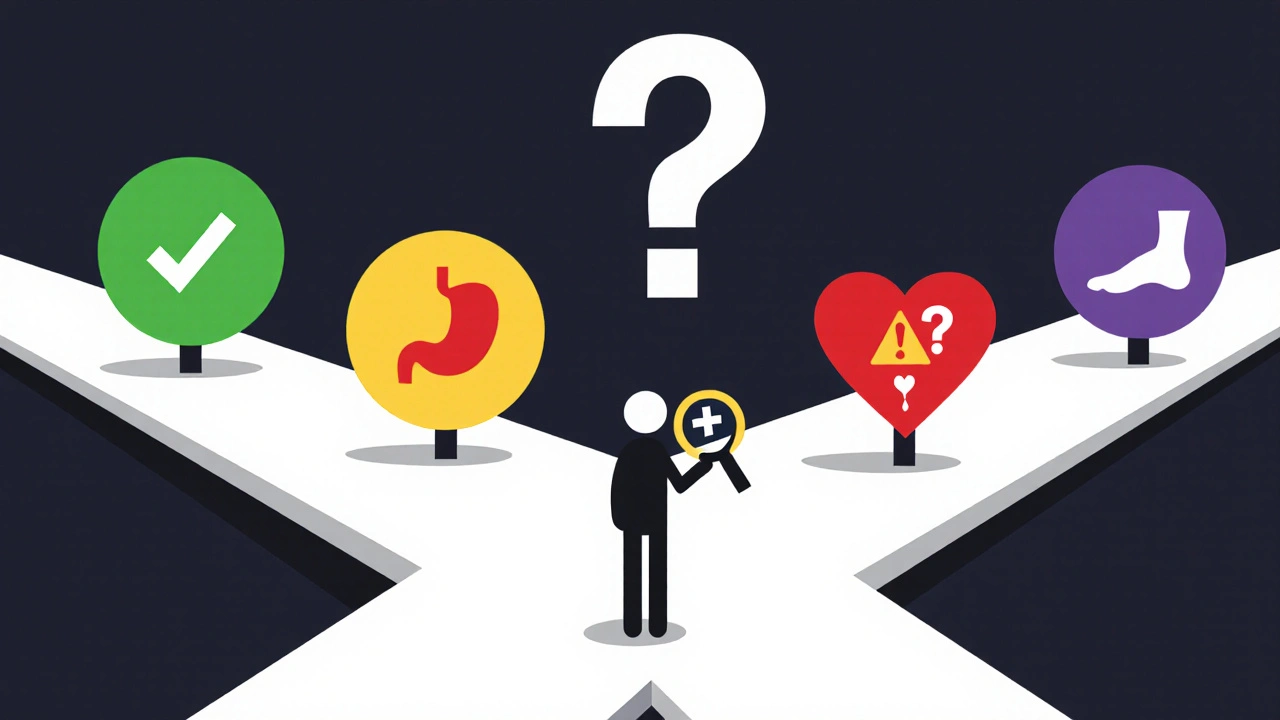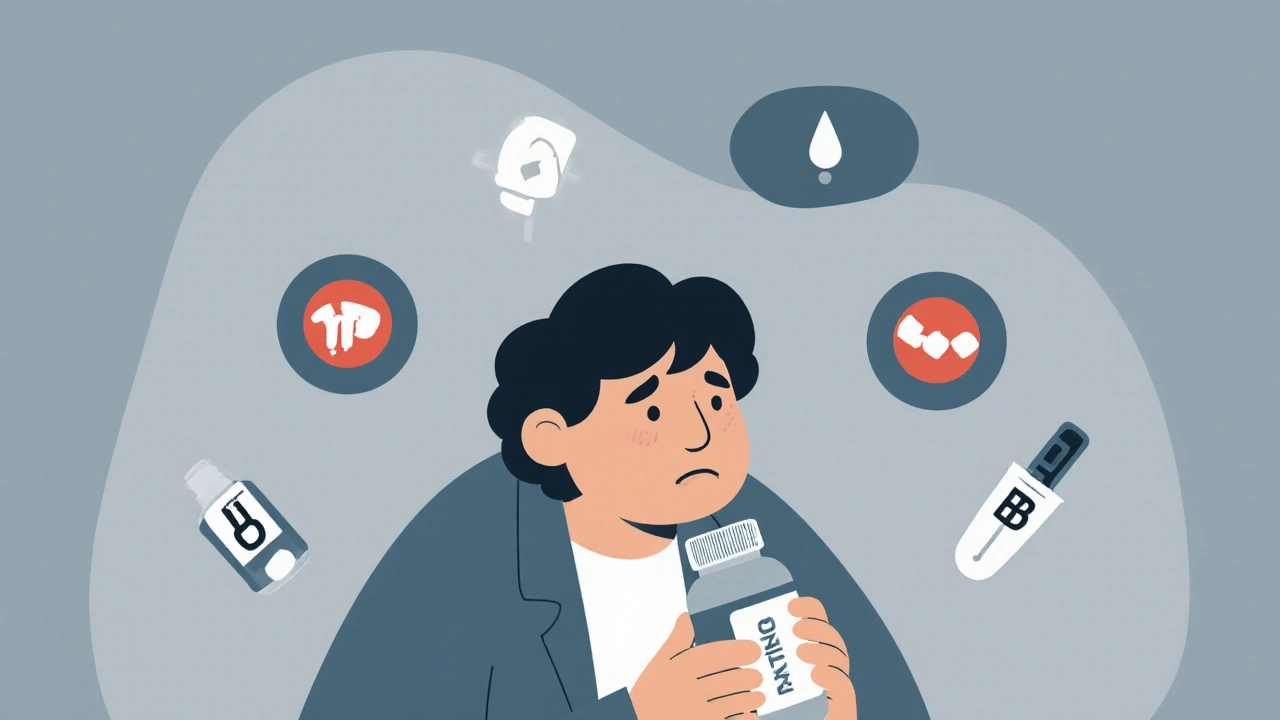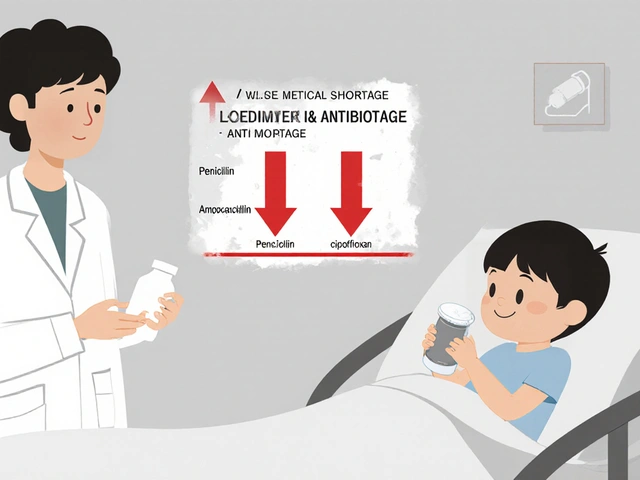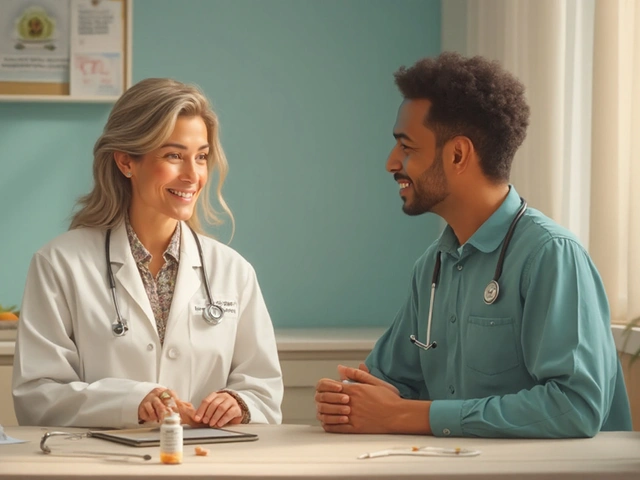Diabetes Medication Selector
Find Your Best Medication Match
Answer a few questions about your health profile and goals to see which diabetes medications might be most suitable for you.
Managing diabetes isn’t just about taking pills or injecting insulin. It’s about navigating a minefield of side effects that can make your daily life harder-sometimes worse than the disease itself. For millions of people with Type 2 diabetes, the medications meant to control blood sugar often bring unexpected problems: stomach pain, low blood sugar, infections, even amputations. And if you’re not prepared, these side effects can derail your entire treatment plan.
Why Side Effects Make Diabetes Harder to Manage
Diabetes medications work in different ways, and each comes with its own set of risks. The goal is to lower blood glucose without causing harm. But in practice, that balance is tricky. About half of all patients stop taking their diabetes meds within the first year-not because the drug isn’t working, but because the side effects are too much to handle. That’s not just inconvenient; it’s dangerous. Uncontrolled blood sugar leads to nerve damage, kidney failure, heart attacks, and blindness.
What most people don’t realize is that side effects aren’t random. They’re predictable. And they’re tied directly to the drug’s mechanism. If you understand how your medication works, you can anticipate and manage the fallout.
Metformin: The First-Line Drug With Hidden Costs
Metformin is the most prescribed diabetes medication in the world. It’s cheap, effective, and doesn’t cause low blood sugar. But it’s also the most likely to wreck your stomach. Between 20% and 30% of people on metformin get nausea, diarrhea, bloating, or loss of appetite. For some, it’s mild. For others, it’s unbearable.
The good news? These symptoms usually fade after a few weeks. The better news? Switching to an extended-release version (like Glucophage XR or Fortamet) cuts GI problems by nearly half. Start low-500 mg once a day with food-and slowly increase. Most doctors skip this advice, leaving patients to suffer needlessly.
There’s another hidden risk: vitamin B12 deficiency. After four or more years on metformin, 5% to 10% of people develop low B12 levels. Symptoms? Constant fatigue, tingling in hands and feet, dizziness, even memory issues. It’s often mistaken for aging or stress. The fix? Get your B12 checked annually. If it’s low, take 1,500 mcg daily. Simple. Life-changing.
Sulfonylureas: The Hypoglycemia Trap
Drugs like glipizide (Glucotrol) and glimepiride (Amaryl) force your pancreas to pump out more insulin. They’re cheap and effective-but they’re also the leading cause of dangerous low blood sugar episodes in Type 2 diabetes.
Up to 20% of users experience hypoglycemia. That means shaking, sweating, confusion, rapid heartbeat, or worse-passing out. It can happen anytime, especially if you skip a meal, exercise more than usual, or drink alcohol. Unlike metformin, sulfonylureas don’t care if your blood sugar is already low. They keep pushing insulin out.
The 15-15 rule is your lifeline: eat 15 grams of fast-acting carbs (glucose tablets, juice, candy), wait 15 minutes, check your sugar. Repeat if needed. But prevention is better than rescue. Use a continuous glucose monitor (CGM). Studies show CGMs reduce severe low blood sugar events by 40%. If you’re on a sulfonylurea and don’t have a CGM, you’re flying blind.
SGLT2 Inhibitors: Weight Loss With a Price
Drugs like Jardiance, Farxiga, and Invokana work by making your kidneys dump sugar out in your urine. The result? Lower blood sugar, weight loss (2-3 kg in six months), and heart protection for those with existing heart disease.
But here’s the catch: you’re peeing out glucose-and that’s a breeding ground for infections. Women get yeast infections 4% to 6% of the time. Men get them less often, but still at 1% to 2%. Urinary tract infections (UTIs) happen in 5% to 10% of users. Some people get recurrent UTIs and have to switch meds.
Worse, there’s a rare but deadly risk: diabetic ketoacidosis (DKA). Even when blood sugar isn’t high, your body can start burning fat for fuel and build up toxic acids. This can happen during illness, fasting, or after surgery. It’s often missed because glucose levels look normal. If you feel nauseous, vomit, or have fruity-smelling breath on an SGLT2 inhibitor, go to the ER.
Another terrifying risk: necrotizing fasciitis (flesh-eating bacteria) and lower limb amputations. Canagliflozin (Invokana) carries a 0.3% to 0.5% higher risk of amputation than other drugs. The FDA requires black box warnings for this. If you have foot ulcers, poor circulation, or a history of amputation, avoid these drugs.

TZDs: The Heart Failure Risk
Actos and Avandia help insulin work better-but they make your body hold onto water. That means weight gain (2-5 kg), swollen ankles, and, in severe cases, heart failure. Rosiglitazone (Avandia) was pulled in Europe and restricted in the U.S. after studies showed a 33% higher risk of heart attack.
Pioglitazone (Actos) is safer for the heart, but still risky if you already have heart failure. The American Association of Clinical Endocrinologists says: don’t use TZDs if you have Class III or IV heart failure. If you’re on one and notice sudden weight gain, shortness of breath, or swelling in your legs, call your doctor immediately.
Alpha-Glucosidase Inhibitors: Gas, Bloating, and Embarrassment
Precose and Glyset slow down carb digestion. They’re rarely used today, but when they are, they cause serious gas, bloating, and diarrhea. Up to 30% of users can’t tolerate them. The reason? Undigested carbs flood your colon and feed gut bacteria, which produce gas. There’s no workaround-just avoid them unless other options are exhausted.
Which Drug Is Right for You?
There’s no one-size-fits-all. Your best choice depends on your body, your risks, and your life.
- If you’re overweight and want to lose weight: SGLT2 inhibitors or GLP-1 agonists (like Victoza) are ideal.
- If you’re at high risk for heart disease: SGLT2 inhibitors or GLP-1 agonists reduce heart attacks and death.
- If you’re elderly or have kidney problems: Metformin is safer than SGLT2 inhibitors if your eGFR is above 30.
- If you’re on a tight budget: Metformin and sulfonylureas are cheapest-but sulfonylureas carry the highest hypoglycemia risk.
- If you hate side effects: Start with metformin ER. Avoid TZDs and alpha-glucosidase inhibitors unless absolutely necessary.
And never assume your doctor knows your full story. If you’re struggling with side effects, say it. Don’t wait until you quit the drug. Bring up your symptoms early. Ask: “What are the most common side effects of this drug? How do I know if they’re normal or dangerous?”

What Patients Are Really Saying
On Reddit’s r/diabetes, one user wrote: “Jardiance dropped my A1c from 8.2 to 6.8-but I had three UTIs in six months. I switched to Victoza. No more infections, and I still lost weight.”
Another said: “Metformin made me feel like I was going to throw up every day. I thought it was just me. Turns out, 42% of people feel the same. Switching to the extended-release version fixed it.”
Mayo Clinic surveys show 68% of patients felt blindsided by side effects. No one told them about the yeast infections, the B12 loss, the low blood sugar risks. They weren’t warned. They were just handed a script.
How to Fight Back
You can’t eliminate side effects-but you can reduce them.
- Start low, go slow. Especially with metformin and SGLT2 inhibitors.
- Take metformin with food. It cuts nausea by half.
- Ask for a B12 test every year if you’ve been on metformin for more than 4 years.
- Use a CGM if you’re on sulfonylureas or insulin.
- Drink water. It’s the best defense against SGLT2 inhibitor infections.
- Don’t ignore genital itching or frequent UTIs. Treat them early.
- Ask about combination pills. Xigduo XR (dapagliflozin + metformin) reduces GI side effects by 25% compared to taking them separately.
Side effects aren’t a sign you’re doing something wrong. They’re a sign your treatment needs tweaking. The best diabetes care isn’t about hitting an A1c target. It’s about finding a medication you can live with-for years, not months.
What’s Next?
The future is personalized. Researchers are now testing genetic tests to predict who will get severe metformin nausea or dangerous low blood sugar from sulfonylureas. If you carry the ADL-1 variant, your risk of GI side effects is 3.2 times higher. If you have the CYP2C9*3 variant, your hypoglycemia risk doubles. These tests aren’t mainstream yet-but they’re coming.
And someday, glucose-responsive insulin and closed-loop systems may replace most oral meds. But until then, knowing your medication’s risks-and how to manage them-is your best tool for staying healthy.
Can diabetes medications cause long-term damage?
Yes, some can. Long-term metformin use can lead to vitamin B12 deficiency, which may cause nerve damage if untreated. SGLT2 inhibitors carry a small but real risk of amputations and rare infections like necrotizing fasciitis. TZDs can worsen heart failure. These aren’t common, but they’re serious. Regular monitoring and open communication with your doctor reduce these risks significantly.
Why do I keep getting yeast infections on my diabetes medication?
SGLT2 inhibitors make your body dump sugar into your urine. Yeast thrives on sugar. That’s why women are more likely to get vaginal yeast infections and men can get penile yeast infections. Drinking plenty of water, practicing good hygiene, and using cranberry supplements can help. If infections keep coming back, talk to your doctor about switching meds.
Is metformin still the best first choice for Type 2 diabetes?
For most people, yes. It’s effective, safe for the heart, doesn’t cause low blood sugar, and is inexpensive. But if you have severe stomach issues, your doctor should switch you to the extended-release version. If you’re overweight or have heart disease, newer drugs like SGLT2 inhibitors may be better. Metformin isn’t perfect-but it’s still the best starting point for most.
What should I do if I feel dizzy or shaky after taking my diabetes pill?
That’s likely low blood sugar. Eat or drink 15 grams of fast-acting sugar-like 4 ounces of juice, 3-4 glucose tablets, or 1 tablespoon of honey. Wait 15 minutes, then check your blood sugar. If it’s still below 70 mg/dL, repeat. If you’re on a sulfonylurea, this could happen often. Talk to your doctor about lowering your dose or switching meds.
Can I stop my diabetes medication if the side effects are too bad?
Never stop without talking to your doctor. Stopping suddenly can cause your blood sugar to spike, increasing your risk of complications. Instead, tell your doctor exactly what you’re experiencing. There’s almost always a better option-whether it’s a different drug, a lower dose, or a combination pill. Your comfort matters as much as your A1c.





